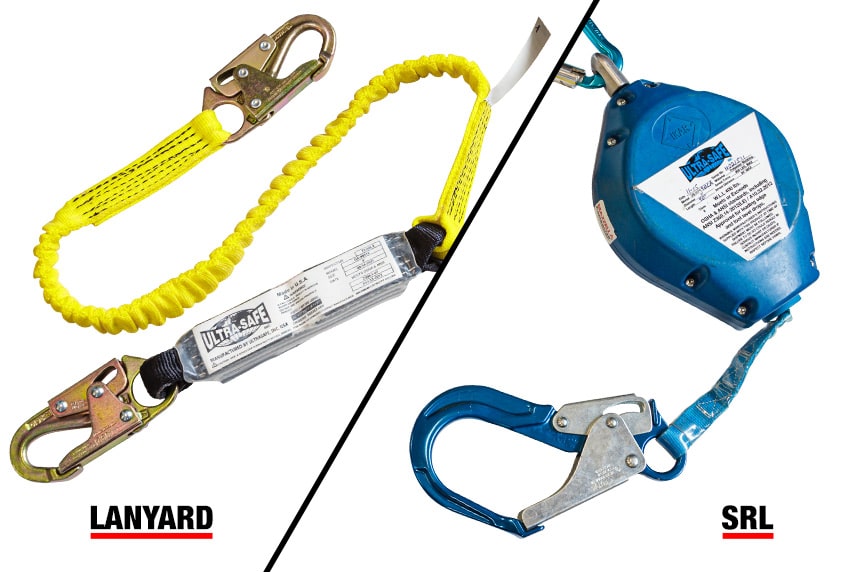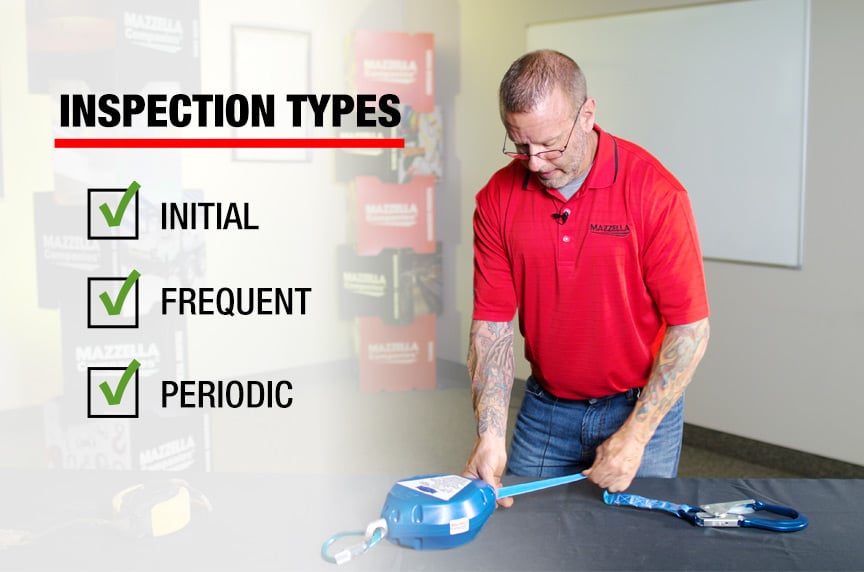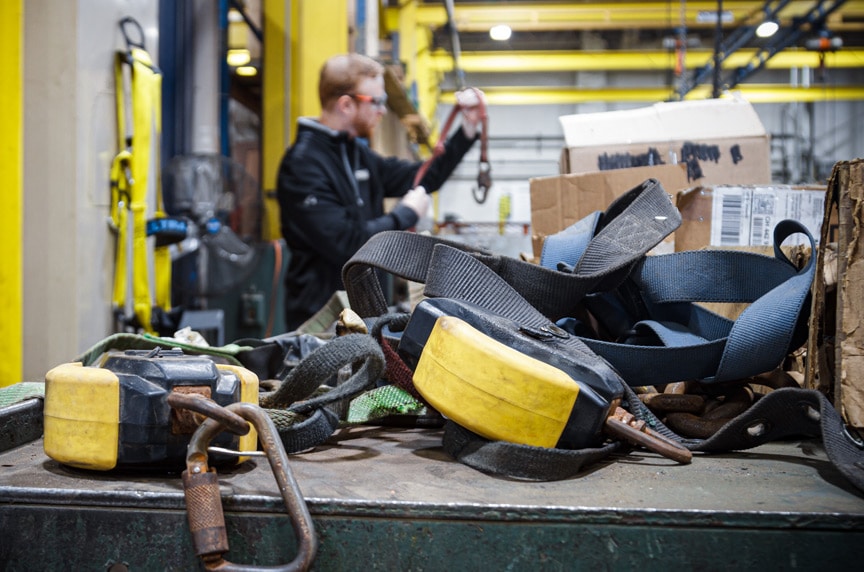What Is the Inspection Criteria for Fall Protection Lanyards, SRLs?
Do you know the rejection criteria for your fall protection lanyard and / or SRL? There are many types of damage that, independently of each other, will require a lanyard and / or SRL be removed from service.
“Carefulness costs you nothing. Carelessness may cost you your life.”
A safety saying from the early 1900s is as true today as it was when it was first spoken, especially as it relates to personal fall protection equipment. Wearing personal fall protection equipment while working at height, including lanyards and self-retracting lifelines (SRLs), is the key to returning home safely at the end of every shift.
Lanyards and SRLs are critical pieces of “personal fall protection,” and approved for use in:
- Fall arrest
- Positioning
- Confined space rescue
- Ladder climbing devices
It is of utmost importance to keep lanyards and SRLs in proper working condition to protect yourself against a failure that could result in injury or death.
In this article, we will look at the following:
- What personal fall protection equipment needs to be inspected?
- If a lanyard / SRL tag is legible, what happens next?
- What type of inspections shall a lanyard / SRL receive?
- Who performs lanyard / SRL inspections?
- What are the requirements for a lanyard / SRL inspection?
Why Is Personal Fall Protection so Important?

According to OSHA Publication 2056, there are nearly 6,000 workplace fatalities in the United States and 50,000 deaths due to workplace-related illnesses each year. Also, there are 5.7 million non-fatal workplace injuries, and those injuries alone cost U.S. businesses over $125 billion annually.
Falls are the leading cause of death in the construction industry, and most fatalities happen when employees fall from open-sided floors and through floor openings. Falls from as little as 4’ to 6’ can cause long-term time away from work, or death. This means all open-sided floors and platforms 6’ or more in height must be guarded.
Personal fall protection involves the use of several components, including:
- Harnesses
- Lanyards
- Self-retracting lanyards (SRLs)
- Anchor points
Anchor Point
Anchor points serve as the secure point for lanyards, lifelines, or other deceleration devices, which is part of the short lanyard attached to the rope grab and full-body harness.
There are two types of anchor points:
- Temporary
- Permanent
With temporary anchor points, employees should use solid structures, such as structural support members.
Permanent anchorage points must be designed by a qualified person and approved by a registered professional engineer. These points must have a safety factor of at least twice the maximum anticipated force during a fall.
What Is a Lanyard and an SRL?

Lanyard
A lanyard is a flexible rope or strap with connectors on each end to connect to a body belt or harness, and then, to a lifeline, anchor or braking (deceleration) device.
Types of lanyards include:
- Self-retracting-Eliminates excess slack in the lanyard
- Shock-absorbing-Slows and eventually stops the descent and absorbs force
- Synthetic rope-Absorbs some force by stretching
- Synthetic webbing-Strong and absorbs little force
Self-Retracting Lifeline (SRL)
An SRL is a deceleration device that functions like a seatbelt. During normal movement, the SRL can be released or retracted, but if a fall does occur, the device locks, which minimizes the fall length.
What Is Done in a Personal Fall Protection Equipment Inspection?
Along with rigging inspections, Mazzella also conducts personal fall protection soft goods inspections. Soft goods include inspections on the following:
- Harnesses
- Lanyards
- SRL Retractables
Lanyards
Like harnesses and rigging equipment, when inspecting lanyards, Mazzella inspectors will start with the identification tag from the manufacturer to make sure it is completely legible.
On the tag, inspectors are looking for:
- Manufacturer name
- Date of manufacture
- Model number
- Length
- Serial number for traceability
- Type of material
- Arrest force
- Your arrest distance
Lanyards must never be tied in knots to reduce their length. This can reduce the strength of the lanyard by as much as half.
SRLs
First, inspectors will make sure there’s no damage to the casing of the unit itself before examining the top hook portion to ensure it rotates freely and has proper markings. They are verifying there’s no:
- Visual defect
- Damage
- Modification
It’s very important to understand that “moving freely” is at basic fingertip-type pressure, and not excessive force. When an end-user is in the air, there shouldn’t be any fighting to maneuver the top hook. It should move smoothly.
After looking at the top hook, inspectors will work their way down to the bottom to check the bottom hook. Again, they are looking for any visual defects, and that everything operates freely. If everything is locking and staying in place securely, inspectors will make sure proper identification is in place and legible. Following the hooks, inspectors will go over the webbing portion of the SRL.
This visual inspection can take some time because a hand over hand inspection must be performed through the SRL’s entire length. As inspectors do that, they’re going to check the braking system on a very regular basis. It is best that this step is done on a completely clean surface to avoid picking up any debris. If debris attaches to the webbing, it can be pulled back into the unit and damage the SRL or webbing.
Like harnesses, inspectors will conduct hand-over-hand inspections of the webbing, feeling for any damage from:
- Debris
- UV (ultraviolet light)
- Chemicals
- Weld splatter
- Heat damage
- Cuts
- Snags
- Tears
Once inspectors examine the entire length of the SRL, they will again periodically check the brakes for releases and catches. At the end of the visual inspection, if the tag reads legible, and no damage was found, inspectors will document this as a “pass” and leave it in service.

What Type of Inspections Shall Lanyards and SRLs Receive?

If everything is legible on the tag and the lanyard and / or SRL is not disqualified from service, inspectors will conduct a “hand-over-hand” inspection to make sure all of the hardware is original to the item and in place.
Visual Inspection of a Lanyard
Initial Inspection
When you first receive the product from a supplier, you want to make sure it is what you ordered and everything is in proper working condition. You want documentation from the manufacturer to list:
- Manufacturer name
- Model number
- Size of the device
- Date of manufacture
The first thing you should do is make sure the identification tag from the manufacturer is in place and legible. Lanyards, like other fall protection equipment, need to be traceable back to the manufacturer. You want to check that all hooks are operational and contain proper identification. Then, you’re looking for any issues with the stitching. During a hand-over-hand inspection, make sure you’re not feeling anything awkward.
Frequent Inspection
Frequent inspections are similar to initial inspections, and are conducted pre-shift or pre-use.
You’re looking for a legible tag, as well as operational and properly locking hooks. Then, you will make sure the stitching is not being pulled apart. This is where you want to be particular and very slow. If the lanyard is bunching up in an accordion-type of look, you want to make sure you’re inspecting hand over hand, trying to feel into all of the little spaces for any of the following:
- Heat damage
- Weld splatter
- Metal shavings from a machine shop
- UV damage
- Chemical damage
- Cuts
- Tears
- Loose or snagged stitching
- Abrasion on the edges of webbing
Accordion-like lanyards do take more time to inspect because you do want to be as thorough as possible.
As the end-user, you have to refer back to the manufacturer’s recommendations regarding service life, basically against the born-on date. It is not written in a standard that there is a life expectancy for an SRL or lanyard. However, you might find a manufacturer that does have a very specific service life.
Periodic Inspection
At a minimum, a periodic inspection is needed once every year, and not to exceed 12 months. A periodic inspection is a documented hand-over-hand inspection of each lanyard / SRL by a Competent Person. The frequency of the lanyard / SRL inspection is determined by the frequency and severity of its use. Environmental factors will determine how frequently these inspections are necessary.
Visual Inspections of SRLs

There are three types of inspections SRLs shall receive before and during its service life:
- Initial
- Frequent
- Periodic
Initial Inspection
The initial inspection is going to be conducted when you receive the SRL from the manufacturer or distributor. You want to make sure it’s the right piece of equipment for your practical applications. During these inspections, you want to make sure there are no visible defects.
You want documentation from the manufacturer to list:
- Manufacturer
- Model number
- Size of the device
- Date of manufacture
Frequent Inspection
Frequent inspections are similar to initial inspections. They are conducted pre-shift or pre-use. You’re looking for a legible tag, along with operational and properly locking hooks.
Periodic Inspection
At a minimum, a periodic inspection is needed once every year, and not to exceed 12 months. A periodic inspection is a documented hand-over-hand inspection of each SRL. The frequency of the lanyard / SRL inspection is determined by the frequency and severity of its use. Environmental factors will determine how frequently these inspections are necessary.
Who Performs These Inspections?

Generally speaking, end-users will play a large role in the inspection process because they need to inspect their personal fall protection equipment before it is used, as well as after it is removed, if others will be using it. Also, end-users will conduct initial inspections of new lanyards and SRLs to check for defects, and proper fit before they are put into service.
For periodic inspections, third-party companies are often hired to conduct and document their findings on personal fall protection equipment. When a customer hires a third-party company to conduct their periodic inspections, they have designated that company to do the inspection, and make determinations on the service life of personal fall protection equipment.
What Are the Required Markings on the Hooks?
According to the ANSI Z359 Fall Protection Code, markings for connectors shall be sufficient to provide traceability.
You have to go back to the manufacturer and model number to make sure the hooks being used on a product that’s currently in the field are up to current standards.
For versions of SRLs that are of wire rope, including galvanized aircraft cable, or stainless steel aircraft cable, depending on the application, regardless of the length, the inspection is the same. It’s going to be hand over hand, and involves checking the brake. You need to have plenty of space for that wire rope to come out, and not get infiltrated with debris that could damage it as it goes back into the unit.
Also, you want to protect your hands because if you do discover a broken wire, and you’re letting this wire rope run through your hands, it is going to catch you. It is going to do some damage to your hand. By wearing gloves, you safely can catch snags of a broken wire or even a minor bend, dogleg or kink within the rope.
How Can Mazzella Help with Your SRL and Lanyard Inspections?

Rigging inspections are what Mazzella is known for. However, personal fall protection inspections pair well with our rigging inspections.
We can help with your SRL and lanyard inspections, and even repairs. We put all of our inspectors through proper training. Then, we have that paper trail so that when you select us to perform your inspections as a third party, we have that defendable position. When it comes to the repairs of retractables, we do partner with a number of the manufacturers who offer repair services for their devices.
Also, Mazzella provides personal fall protection solutions and engineered lifeline systems to help keep your employees safe at height.
We are a leading supplier and installer of engineered fall protection systems in the U.S., as well as a distributor of soft goods like harnesses, lanyards, self-retracting lifelines, scaffolding and netting. All of our engineered systems and products meet or exceed the federal criteria required by OSHA and ANSI, and can be customized with your personal fall protection and financial needs in mind.
We work with our partners to provide full-body harnesses, as well as many other fall protection products. As workers move at height, these products are designed to secure them when and where a fall may occur.
Call us at 800.362.4601 or click here if you need harnesses or other fall protection equipment!



Fall Protection
We are a leading supplier and installer of engineered fall protection systems in the U.S., as well as a distributor of soft goods like harnesses, lanyards, self-retracting lifelines, scaffolding, and netting.
Copyright 2022. Mazzella Companies.
